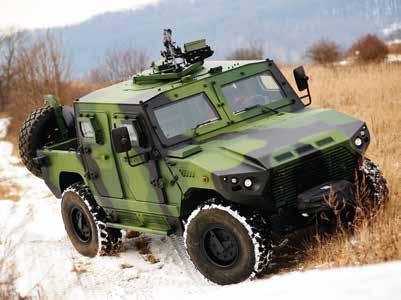
20 minute read
Light armoured
The demonstrator of the Scarabée seen during Arquus’ TechnoDays 2019; we can clearly see the two steering axles. © Arquus
Light armoured vehicles
Advertisement
By Paolo Valpolini
This article was to be an appetiser to the many new vehicles of the light armoured category that we were expecting to be seen in Paris during Eurosatory. Unfortunately 2020 will see very few defence exhibitions running, so we tried to provide our readers with the latest on some well known vehicles and on some novelties that might appear soon. Among the starring Light Armoured Vehicles (LAVs) expected in Paris the Serval, the light member of the French Army Scorpion programme, under development by Nexter and Texelis,, would have certainly be among The Interdiction/Deep Strike (IDS) variant of the Luftwaffe’s Tornado the stars, however we will all have to wait some more time to see it in real. multi-role strike aircraft will be replaced from 2025. © USAF
Remaining in the hexagon, Arquus, part of the Volvo Group, is definitely the main French LAV producer, its portfolio including the Dagger and Sherpa Light. In late May 2020 the company rolled-out the 1,000 Sherpa vehicle, considering Light and Medium versions. Looking at legacy products, the French Army still employs numerous Véhicule Blindé Léger (VBL). Some 800 should be refurbished/upgraded to the VBL Ultima standard, which includes among others the repair and maintenance of part of the automotive components, the replacement of others, and the upgrade of the vehicle protection with add-on kits, the programme having been designed following lessons learned during recent deployments downrange. The production chain was inaugurated in December 2019, the first four
Nexter and Texelis are developing the Serval, the light element of the vehicles designed within the Scorpion French Army modernisation programme; it should have been unveiled at Eurosatory 2020. © Nexter

VBL Ultima being scheduled for delivery to the Direction Générale de l’Armement (DGA) within summer 2020, Arquus aiming at producing a total of 50 vehicles before year end.
Unveiled (only to selected visitors) at Eurosatory 2018, the Scarabée (beetle) innovative 4x4 hybrid vehicle is powered by a 300 hp turbodiesel engine coupled to a 75 kW electric motor, allowing for a maximum speed of 120 km/h. The Scarabée has an 8 tonnes GVW with a 2 tonnes payload and can host a crew of three plus a fourth person. The driver seats at the front, with the other crewmembers being located backwards on the sides, this layout providing maximum situational awareness. The vehicle is fitted with two stearable axles, the rear one being activated by a joystick, this architecture ensuring a 5 meters radius turning circle. According to Arquus the development of this innovative vehicle is progressing according to plans. The Scarabée will certainly be proposed to France for the VBAE (Véhicule Blindé d’Aide à l’Engagement, Armoured Vehicle for Engagement Support) programme, which should be restarted soon, no frozen requirements having yet emerged from the DGA. However the Scarabée might be launched on the export market even before than to the national customer, the first potential date being that of IDEX 2021, COVID-19 permitting. The hybrid vehicle might not be however the only vehicle that keeps Arquus R&D department busy; the successor of the Sherpa should also well be already on the engineers’ computers screens.
Not much new on GDELS Eagle, if not some good news from some additional contracts. In its 4x4 version the General Dynamics European Land Systems Eagle has been successful since inception, and has now reached the fifth generation, the last two being based on the Duro chassis. The Eagle 5 has a 10 tonnes GVW, of which 30 per cent is payload, and can carry up to five soldiers. Two Cummins engines are offered, with respective outputs of 245 and 285 hp. April 2019 marked the delivery of the first of 36 Eagle 5 in patrol configuration to the Danish Army, one of the very first customers of the Eagle 1. Late 2019 saw the first contract for the 6x6 version of

In May 2020 Arquus rolled out the Sherpa n. 1,000, considering both light and medium versions. © Arquus
Arquus is ready to deliver the first VBL Ultima, the assembly line in Marolles having been inaugurated in late 2019. © Arquus
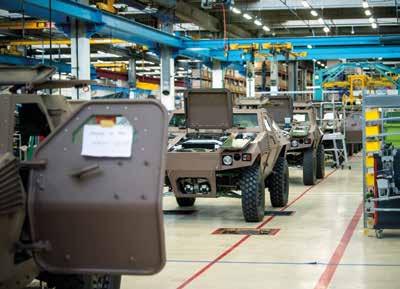
the Eagle, which has a 15 tonnes GVW, with 7.3 tonnes payload and up to 14 seats for the crew and dismounts. On 18 November armasuisse, the Swiss MoD acquisition branch, signed a contract for 100 Eagle 6x6 in the reconnaissance version; these will be fitted with an L3Harris Technologies’ Wescam MX-RSTA electro-optic/infra-red sighting system installed on a telescopic mast and with an Elbit Systems C2 suite. Production should start within 2020 with deliveries planned between 2023 and 2025. In April 2020, a further deal for the Eagle 6x6 was announced by the German BAAINBw, which signed a contract for 80 armoured ambulance vehicles for the German Army. Known as mittleres geschütztes Sanitätskraftfahrzeug(mgSanKfz) they will fill the gap between the Boxer and the Eagle 4x4 ambulances; the new vehicles will transport up to two patients on stretchers with full medical assistance. The crew will be of four, the driver, two emergency paramedics and a doctor forming the medical party. Smoke grenade launchers providing a defensive smoke-screen should be installed. First deliveries are planned for 2021, the programme completion being forecasted in 2024. Some further projects are ongoing at GDELS in the LAV field, however the company declined to comment.
With more than 4,000 delivered in over 17 countries Iveco DV LMV is definitely one of the main European LAVs , the main customer being
In the last few months GDELS bagged the first two orders for its Eagle 6x6 vehicle, one from Germany that acquired the vehicle in the ambulance version. © GDELS
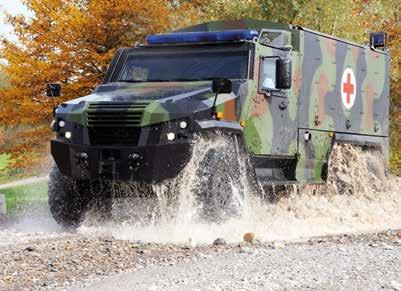
Italy, which received over 2,000 vehicles. The original LMV evolved considerably, augmenting its GVW up to 7.1 tonnes while the increasing demand for protection coming from the field was met at the expenses of the payload, which was consequently eroded down to less than 1,000 kg. The on board power was also increased, adopting a more powerful alternator to cope with numerous subsystems, among them the powerhungry C-IED jammer.
Iveco DV is answering recent export contracts providing its customers with dedicated versions obtained with the insertion of the various subsystems developed during the last years. An example is that of Brazil that selected the LMV in February 2018; an urgent operational requirement initially was answered by the Italian Army providing 16 vehicles taken from the refurbished vehicles stock, Italy having launched a programme to restore its LMVs of the first batches. Known as Lince K2, the work consists in adding a second roof hatch, replacing the alternator and part of the electric circuit, as well as some mechanical subsystems. Brazil, then filed a contract to Iveco DV for 32 new vehicles produced according to the original requirement, which includes elements of the of the latest versions.
In 2013 Iveco DV started developing the wholly new LMV 2, which maintains its predecessor

look. At 8.1 tonnes GVW its payload exceeds 1.5 tonnes while ensuring a much higher protection against ballistic and blast threats. Currently only Italy has ordered the LMV 2, named Lince 2, a first batch of 34 vehicles fitted as nodes for the Army digitisation programme known as Forza NEC being ready for delivery. In the mean time the Army launched a crash programme in order to put into service in short time 16 Lince 2 “Light”, the adjective referring to the C4I component. Deliveries are expected 14 months after the contract effectiveness. The 2019 pluriennial programme calls for the acquisition of 650 Lince 2, although 400 seems to be considered a more realistic number. Beside the national programme, Iveco DV is steadily promoting its LMV 2 on the international market.
The last addition to the company portfolio is the 12 kN, the provisional name of the vehicle under development for the Netherlands. In November 2019 a contract for 918 vehicles was signed, the
The second generation LMV by Iveco DV is fully developed, the first vehicles awaiting delivery to the Italian Army. © Iveco DV
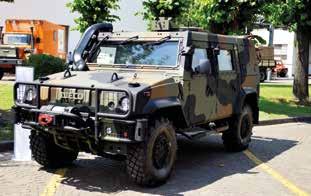
prototype being expected for Q3 2020 to carry out company trials prior being delivered to the customer for trials and qualification. The 12kN will be used in operations with an intermediate level of risk, part of the fleet being protected, part fitted for protection and part unprotected. The 12kN is based on a purposely developed chassis that exploits the work done on the militarised Eurocargo series, but with much improved performances, the engine being a derivative providing an output more than twice that of the LMV. The original potential number announced was 1,275, the Netherlands aiming at acquiring at a later date the 357 remaining vehicles with follow on orders when budget will be available. The 12kN will allow Iveco DV to operate in market areas where less sophisticated vehicles than its LMV are required, widening the company opportunities.
In 2013 Rheinmetall of Germany and Achleitner of Austria signed an agreement to develop the Survivor 4x4 armoured vehicle, which was then based on an MAN TGM 13.280 chassis. The two companies funded a development which led to an improved vehicle, based on the MAN 18.330 chassis, known as Survivor R in Germany and PMV Survivor II in Austria. Technical data differ as they depend very much on configuration, maximum GVW been at 17 tonnes, total axles load being 17.6 tonnes. The Rheinmetall basic vehicle has a 15 tonnes GVW and a 4.1 tonnes payload, and is powered by a 330 hp MAN engine coupled to a 12 AS 1210 TipMatic automatic transmission with a MAN G103 2-speed transfer case. The basic
The only rendering available of Iveco DV’s 12kN, the vehicle being developed for the Netherlands, which prototype should be ready in late 2020. © Iveco DV
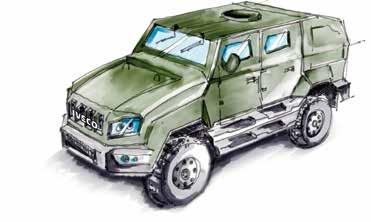
armour is provided by the monocoque steel hull, add-on ceramic armour kits being available to improve protection levels, the considerable payload allowing flexibility in that area. Proposed both to military and police customers, the Survivor R has bagged contracts in the latter market area: national customers are mainly SWAT teams, such as the Austrian Einsatzkommando Cobra as well as German Spezialeinsatzkommando of two Land, Sachsen and Northrhine Westfalia. The Berlin Police also adopted the vehicle. As for export an undisclosed Asian country acquired 15 vehicles for its Border Guard. The very last application sees the 4x4 used as the platform for a Counter-UAS concept study known as Skymaster Mobile.
For Otokar, the Turkish company specialized in military and commercial vehicles belonging to the Koç Holding A, the Cobra 4x4 is definitely a best-seller, over 4,000 vehicles in 35 different configurations operating with more than 20 customers worldwide. With the latest versions at 6,300 kg GVW and a 1,100 kg payload, powered by a 190 hp engine, Otokar has launched a modernization programme and the first refurbished vehicles are ready to be tested by the customers. A much heavier vehicle, the Cobra II provides increased protection against ballistic and blast threats, while carrying the same nine military; at 12-13 tonnes GVW, it is powered by a 360 hp engine and can reach 110 km/h, its range being 700 km. Over 600 Cobra II were delivered in more than 10 variants.
Rheinmetall’s Survivor R is being used to develop the Skymaster Mobile Counter-UAS concept study. © Rheinmetall

The Akrep 4x4 was launched in 1994, and 25 years later Otokar unveiled its successor, the Akrep II. Compared to the 3.6 tonnes GVW Akrep, the Akrep II has a combat weight of 13.5 tonnes, its main feature being the reduced height, 1.78 meters while maintaining a 400 mm ground clearance.
At IDEF 19 the vehicle was exhibited in the allelectric version, powered by two motors providing 180 kW each, ensuring motion respectively to front and rear wheels, a pack of Li-Ion batteries providing a 200 km range. The Akrep IIe features front and rear (optional) steering wheels and is fitted with independent suspensions. Its low acoustic and thermal signatures, together with its low silhouette, make it a stealth vehicle, perfect for reconnaissance missions, its three-man crew being optimal for such duties. The Akrep II has the same baseline protection of the Cobra II, and can also be used as a fire support vehicle; exhibited with a new modular Bozok remotely controlled turret armed with a 25 mm cannon, Otokar states that the vehicle can be fitted with a one man 90 mm turret, meaning a considerable payload capacity that can also be exploited to increase baseline protection to much higher levels. The all-electric version was definitely an R&D item, qualification tests being currently in progress. Otokar designed the engine compartment to allow hosting different solutions, such as hybrid or full diesel. Both are in the design phase, the company having announced in 2019 that the diesel version should be available by 2020.
Over 4,000 Cobras have been sold by Otokar along the years; here a vehicle showing its amphibious capability. © Otokar

Part of the Nurol Group of Turkey, Nurol Makina is responsible for 4x4 military and paramilitary vehicles. Among LAVs, the NMS is the last born: unveiled at IDEF 2017, its development was frozen in 2019 when it was also qualified. The NMS 4x4 is based on a V-shaped monocoque hull fitted with fully independent suspensions and is powered by a 300 hp diesel engine allowing for a 140 km/h maximum speed over road and a 700 km range at cruise speed. With a maximum GVW of 12 tonnes, its payload varies from 1.5 to 3.5 tonnes, depending on the protection level that can be increased from the basic Level 1 up to Level 4, no details being available on antimine protection. The launch customer on the export market was Qatar, which Special Forces announced in 2018 the potential acquisition of 214 vehicles in five different configurations.
Heavier and more protected than its predecessor, Otokar’s Cobra II has already bagged numerous export orders. © Otokar

The standard troop transport configuration sees the two-man crew at the front, with three more soldiers sitting in the second row of forwardlooking seats, these boarding and debussing the vehicle from the four side doors. Four more soldiers are hosted on the inside-looking seats in the rear compartment, accessible via a fifth door. Nurol Makina proposes its vehicle in numerous variants, with full cabin, as well as in pick-up configuration with single or double-cabin. Another customer is Hungary, which displayed the prototype vehicle during the 2019 National Defence Day. One more export contract adds to the two aforementioned ones, to which that with Turkey must also be added. First deliveries are awaited in 2020, the company expecting the NMS Yörük to become best-seller, exceeding the success of the Ejder Yalcin.
In 2019 Otokar unveiled the Akrep II, which was first shown in an all-electric version, hybrid and diesel versions being under development. © Otoka

The latter is a 14 tonnes GVW MRAP type vehicle also based on a monocoque V-shaped body fitted with a floating floor system and energy-absorbing seats, providing a Level 4a/3b mine protection. It can carry up to 11 soldiers, its payload being 4 tonnes, and is powered by a 375 hp engine. Beside Turkey, six other countries have adopted the Ejder Yalcin, the last being Hungary, almost 1,000 such vehicles having already been delivered and deployed in Europe, Africa, GCC and Central Asia. Nurol Makina underlines that after a first order many customers filed additional ones. The COVID-19 related crisis led to the postponement
Also known as Yörük (Nomad) in Turkey, the NMS 4x4 is the latest development by Nurol Makina, first deliveries being expected within 2020. © Nurol Makina

of contracts with at least three new countries, which remain undisclosed.
Plasan, the Israeli company which name is well known for being one of the key players in the armour solutions field, has launched in the early 2000s its 4x4 light armoured vehicle, the SandCat. The vehicle has gone through a series of iterations, the one currently under production being the Mk IV. Based on a Ford 550 chassis with minor modification, the latest model has a GVW of 8,800 kg with a 2,000 kg payload capacity, considering the B6/7 protection level, the floor being protected at Level 1 against mines; part of the payload can be used to increase ballistic protection up to STANAG Level 2/3. Powered by

Nurol Makina Ejder Yalcin has obtained a considerable success, the company awaiting three more export contracts in the near future. © Nurol Makina
a Ford 6.7L V8 OHV Power-Stroke Turbo-Diesel engine, providing a power-to-weight ratio of over 35 hp/t, fitted to a Heavy duty TorqShift 6-speed automatic transmission with SelectShift and a 2-speed electronically operated transfer case, it can reach a maximum speed of 120 km/h and overcome a 60% gradient. The 135 litres fuel tank ensures an operational range of 500- 550 km depending on mission profile. The latest version is available in different configurations, transport with up to 11 seats in full-length cabin, utility with a shorter cabin for five occupants, and single cab, for up to three personnel with an unprotected rear payload area. An M-LPV version (Mine-resistant Light Patrol Vehicle) version is also available; slightly longer, it has a 9,300 kg GVW and a 1,100 kg payload, and ensures a much higher mine protection, Level 2a/2b and standard Level 2 ballistic all-round protection. Beside Israel, the SandCat is in use by police, paramilitary and military units in Bulgaria, Canada, Chile, Colombia, Kazakhstan, Mexico, Nigeria, Poland, South Korea, Sweden and Ukraine, however according to the latest information the number of countries using the Plasan LAV are at least 19, some of them remaining unveiled. Part of the success of the SandCat is that Plasan is ready to provided it in kits to be assembled locally.
The latest add-on to the SandCat family is the StormRider: keeping the same Ford 550 powertrain, the power-to-weight ratio being reduced to 30 hp/t, the new vehicle is not based on a chassis but is of the monocoque type, featuring independent suspensions. This allows a considerable improvement in protection and mobility. While dimensions remain similar the GVW increases to 11,500 kg, payload being 1,500 kg, protection being Level 3 on the 360°, Level 2 on the roof and Level 2a/2b antimine. Off-road mobility is considerably improved thanks to the front and rear independent suspensions, with coil springs and hydraulic shock absorbers, the wheels diameter being increased the StormRider mounting 365/80 R20 150k, compared to the 285/70 R 19.5 of the SandCat, a run-flat system being available as option. The StormRider is production ready.
This picture sums up the evolution of Plasan’s_SandCat family, from right to left the original SandCat, the MLP-V and the StormRider, which first vehicles will be delivered in late 2020. © Plasan

Stepping from a full military vehicle to a paramilitary one, the other addition to Plasan’s LAV portfolio was announced at Eurosatory 2018 in the form of the Hyrax. Based on the Mercedes G-Wagen chassis, it can carry up to six people in an armoured cabin providing a B6 protection level as standard, which can be upgraded to B7 or STANAG Level 2. The floor provides a Level 1 blast protection, no growth potential being available. The Israeli company offers four different seats layout to cope with all possible customers requirements, the roof being able to host an RCWS armed with up to a 12.7 mm machine gun. At 4,800 kg GVW, the Hyrax has a payload of 810 kg. The Hyrax is production ready and has gone through numerous customers’ trials. Unveiled in 2015, the armoured variant is known as Ajban 440A, and can carry four soldiers. Nimr does not declare the standard ballistic and mine protection, however among optional features we find ballistic packages up to Level 4 and blast packages up to Level 3a/3b. The vehicle is fitted out with a battlefield management system, central tire inflation system, run flat inserts, battery management system, and a self-recovery winch. Overall, the UAE company has produced more than 2,500 variant vehicles, most of them for the national customer or other GCC armed forces, with some vehicles also being sold to nations elsewhere. A production line was established in Algeria following an agreement signed in 2012.
Nimr is among the leading LAV players in the Middle East, and is renowned for the Ajban family of 4x4 vehicles that was developed over the last decade. Powered by a Cummins ISBe 300 6.7 litre six-cylinder, 296 hp engine, and capable of a maximum speed of 110 km/h, the 180-litre fuel tank ensures a 700 km cruising range. The vehicle is fitted with double wishbone independent suspensions with coil springs and hydraulic dampers to provide increased cross-country mobility.

Aiming mostly at the paramilitary market, Plasan’s Hyrax is based on rhe Mercedes G-Wagen chassis. © Plasan
In November 2019 Nimr became part of Edge, an advanced technology company that has consolidated the UAE’s leading defence and technology companies. This allows Nimr to find synergies as far as market opportunities are concerned, and to leverage the capabilities of other group members to further advance its products. Protection, propulsion, digital architecture, and integration are all aspects currently offered. Talking recently to Nimr officials, EDR Magazine learned that a further evolution of the Ajban is The first generation Ajban family of vehicles is built on a common chassis, the armoured variant being the 440A. © Nimr already underway. While the 440A is considered a 1.0 vehicle, the 447A is a 1.5 generation solution, unveiled At IDEX 2019, Nimr unveiled a new version, to understand market reactions and will probably the Ajban 447A MRAV (Multi-Role Armoured remain at technology demonstrator level. IDEX Vehicle). Similar in dimensions to the Ajban 2021 should see Nimr unveiling the Ajban Mark 440A, it carries two crew members and up to 2 that is likely to maintain the 447A transport five dismounts, and has a payload between capability, hosting up to seven soldiers, and 2,000-3,000 kg, which allows users to increase offering higher performances across the board. the protection level while maintaining sufficient Modularity is likely to be a further add-on. transport capacity. The baseline protection level is also higher than that of the previous version. Currently Nimr has an overall production capability of 1,500 vehicles per year. However, In addition the self-sealing tank and critical engine with an eye on the export market, the company ballistic protection, which on the 440A are optionis open to various type of cooperation schemes, al, are standard offering in the 447A. Kerb weight including joint ventures based on local production is at 9,700-11,100 kg, leading to a gross weight of for either full or kit assembly. 12,500-13,100 kg. The standard engine is 300 hp, however Nimr is also proposing a 360 hp engine that will allow maintaining the power-toweight ratio at over 27.5 hp/t. The vehicle offers mobility performances similar to the 440A, including 60% slope, 0.7 metre trench, 0.4 metre step, 1 metre fording, and higher maximum speeds of up to 120 km/h. Four side doors are available, two front-hinged for the crew and two rear-hinged for dismounts, with a rear door offered as an At IDEX the Ajban 447A was equipped with a Platt MR550 shielded ring mount armed optional feature. with an M134D Dillon 7.62 mm Gatling machine gun. © P. Valpolini
